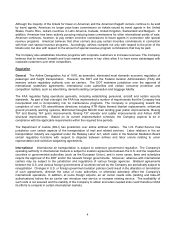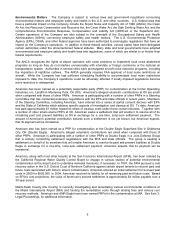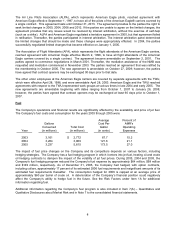American Airlines 2005 Annual Report Download - page 17
Download and view the complete annual report
Please find page 17 of the 2005 American Airlines annual report below. You can navigate through the pages in the report by either clicking on the pages listed below, or by using the keyword search tool below to find specific information within the annual report.14
We need to raise additional funds to maintain sufficient liquidity, but we may be unable to do so on
acceptable terms.
To maintain sufficient liquidity as we continue to implement our restructuring and cost reduction initiatives, and
because we have significant debt, lease, pension and other obligations in the next several years, we will need
continued access to additional funding.
Our ability to obtain future financing has been reduced because we have fewer unencumbered assets available
than in years past. A very large majority of our aircraft assets (including virtually all of the aircraft eligible for the
benefits of Section 1110 of the U.S. Bankruptcy Code) have been encumbered. Also, the market value of our
aircraft assets has declined in recent years and those assets may not maintain their current market value.
Since the Terrorist Attacks, our credit ratings have been lowered to significantly below investment grade. These
reductions have increased our borrowing costs and otherwise adversely affected borrowing terms, and limited
borrowing options. Additional reductions in our credit ratings could further increase borrowing or other costs and
further restrict the availability of future financing.
A number of other factors, including our recent financial results, our substantial indebtedness, the difficult revenue
environment we face, our reduced credit ratings, high fuel prices, and the financial difficulties experienced in the
airline industry, adversely affect the availability and terms of financing for us. As a result, there can be no
assurance that financing will be available to us on acceptable terms, if at all. An inability to obtain additional
financing on acceptable terms would have a material adverse impact on us and on our ability to sustain our
operations over the long term.
Our business strategy may change.
We evaluate our assets on an ongoing basis with a view to maximizing their value to us and determining which
are core to our operations. We also regularly evaluate our business strategy. We may change our business
strategy in the future and may not pursue our current goals.
Our business is subject to extensive government regulation, which can result in increases in our costs,
limits on our operating flexibility and competitive disadvantages.
Airlines are subject to extensive domestic and international regulatory requirements. Many of these requirements
result in significant costs. For example, the FAA from time to time issues directives and other regulations relating
to the maintenance and operation of aircraft, and compliance with those requirements drives significant
expenditures. In addition, the ability of U.S. carriers to operate international routes is subject to change because
the applicable arrangements between the United States and foreign governments may be amended from time to
time, or because appropriate slots or facilities are not made available.
Moreover, additional laws, regulations, taxes and airport rates and charges have been enacted from time to time
that have significantly increased the costs of airline operations, reduced the demand for air travel or restricted the
way we can conduct our business. For example, the Aviation and Transportation Security Act, which became law
in 2001, mandates the federalization of certain airport security procedures and imposes additional security
requirements on airlines. Similar laws or regulations or other governmental actions in the future may adversely
affect our business and financial results.
























